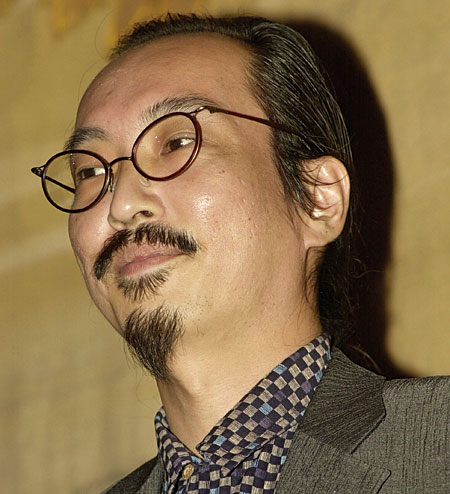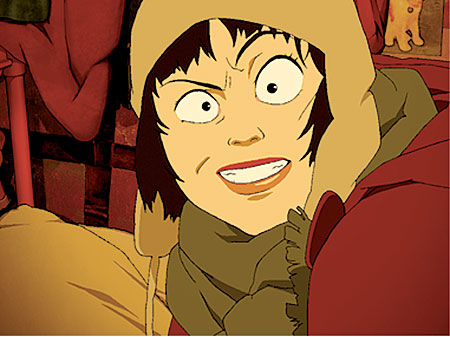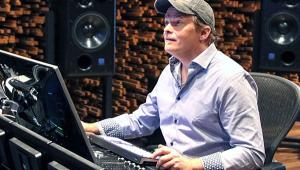HT Talks To . . . FilmMaker Satoshi Kon

Can you describe your involvement in creating an Anime film?
I'm involved in the entire process of animation production, from the preproduction stage to creating the visuals to be used on posters and flyers to publicize the film's release. With my original stories, such as Sennen joyu, Tokyo Godfathers, and Mousou dairinin, I make it a point to start with thinking up the story idea. It would be more accurate to say that I figure out whether or not the idea that I came up with could be made into a film, rather than to say that I come up with an idea in order to create a film.
I take that idea and organize it into a plot. Then, with the scenario writer, we expand on that story and work on character design. Then we get into the storyboard. With animation, these storyboards play an extremely important role. With theatrical works, I draw all of the cuts for the storyboard and note such things as the characters' acting and expressions. In terms of adding the characters' performance, drawing the background scenery, and deciding on colors, they are, of course, created in detail later on.

Tokyo Godfathers
Since we create most of the characters' general movements and expressions on the storyboard, as well as the basic composition and lighting of the scenes and timing issues, the storyboard's content is almost the same as what appears onscreen in the final product.
Then we take the materials that we have gathered and film them—although, nowadays, it is composed digitally—to create a single cut. All the cuts are edited, and then we add sound. In the United States, it's more common to record the voice first and then to create the drawings by matching them to the voice. But, in Japan, the after-recording method is mainly used. The work is completed when we burn the finished digital data onto 35-millimeter film. And then the time comes when all the staff watches the initial screening of the work with both joy and concern. Each process is really enjoyable.

Perfect Blue
All of this concerns how things go for a theatrical work. We created the first and last episodes of Mousou dairinin in a similar manner. For the other episodes, I check the scenario and the storyboard created by each episode's head staff. I am present during the editing and sound creation that follow, but, because we most value each episode's individuality with Mousou dairinin, I think the unique style of each episode's staff that is in charge of direction is well pronounced in each episode.
How long does it typically take to develop each story?
When we think about a plan, we have already decided on a particular idea as far as what we want to create. I simply take that framework and make it into a plot. Then a producer at the production company, Madhouse, either gives me a "Go" or an "NG." The time that's required to solidify a plot varies with each work. With short cases, such as with Tokyo Godfathers, it takes about a month.
From there, it takes about six months to create the scenario and design the characters. After that, we go into the storyboard and concurrently start the actual production. I would say it takes approximately two to two and a half years from the planning stage to the finish.

Mousou dairinin (Paranoia Agent)
From where do you draw inspiration?
My ideas come from ordinary day-to-day living, such as watching movies, reading books, listening to music, and talking with friends. I get ideas that are linked to trends around the world, but I just take in information from TV, newspapers, and the Internet in a normal way, and I don't conscientiously conduct any information gathering. The particular moments when I come up with ideas really varies. However, I feel the easiest moment to extract an idea is when I'm talking with someone. When I'm talking with someone, I feel like my mind opens up in some ways.
What are some of the biggest challenges your creative team has to face when making a feature film?
Budget, time, and gathering the staff. There are a lot of familiar faces among the staff, and I think the accumulated know-how among those staff members is linked to a performance that goes beyond the budget. As for the scope of a budget, for Tokyo Godfathers, the actual production budget is approximately 300 million yen [about $2.7 million]. For last year's theatrical animation work, you can't really call that a big budget. But I think that the work's quality is higher than the budget, and that is solely due to the staff's ability.

Sennen joyu (Millennium Actress)
In recent years, CG animation has become a popular art form among filmmakers. What do you see as the future of hand-drawn anime?
I believe it is true that hand-drawn anime is on a declining trend, especially in the United States. That trend is also true in Japan, but Japanese animation is something that originally grew with the culture of manga comic books. The manga culture is unique to Japan, and it permeates throughout a wide audience. Also, you can't really say that a 3-D method is that suitable when it comes to reproducing manga, because, after all, manga itself is a hand-drawn 2-D medium. That's why, in Japan, although we will see an expansion of 3-D animation, I do think that 2-D animation will also remain.
How might you explain the importance of Anime in Japanese/Eastern culture?
Manga culture cannot be seen anywhere else but in Japan. Manga has positioned itself alongside other cultural elements, such as films, TV, and literature. It's been received as a form of expression that has no substitute for many people. Just like there are certain nuances that can only be expressed using Japanese language or certain feelings that can only be relayed in English, there are those things that could only be told through manga. Japanese people are familiar with the way manga communicates. There are things that can be depicted and nuances that can be conveyed only through animation. As long as that function is difficult to replace, I think it's important as a culture, and I also feel that a Japanese-style animation will continue to be succeeded over generations.

What is your favorite Anime film?
I've been involved with manga and animation since I was a child. I was crazy about Uchu senkan Yamato (Space Battleship Yamato) and looked forward to Arupusu no shjo Haiji (Heidi: Girl of the Alps). However, ever since I started to work on animation myself, I watch fewer animations. And, even when I do watch them, I tend to watch them from a professional perspective, so it's hard for me to enjoy them innocently. When it comes to work that I directed myself, I tend to get even more critical as a professional, so it's difficult to enjoy it. It's more enjoyable to create them.
*A special thanks to DreamWorks for arranging this interview and to Satoshi Kon-san.





























































